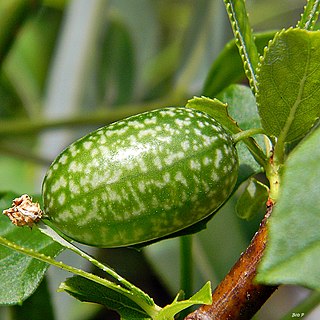
The Cucurbitaceae, also called cucurbits or the gourd family, are a plant family consisting of about 965 species in around 95 genera, of which the most important to humans are:

Tibouchina is a neotropical flowering plant genus in the family Melastomataceae. Species of this genus are subshrubs, shrubs or small trees and typically have purple flowers. They are native to Mexico, the Caribbean, and South America where they are found as far south as northern Argentina. Members of this genus are known as glory bushes, glory trees or princess flowers. The name Tibouchina is adapted from a Guianan indigenous name for a member of this genus. A systematic study in 2013 showed that as then circumscribed the genus was paraphyletic, and in 2019 the genus was split into a more narrowly circumscribed Tibouchina, two re-established genera Pleroma and Chaetogastra, and a new genus, Andesanthus.

Cucumis is a genus of twining, tendril-bearing plants in the family Cucurbitaceae which includes the cucumber, muskmelons, the horned melon, and the West Indian gherkin.

Henriettea is a tribe of flowering plants in the family Melastomataceae, with some 399 species accepted. It is distributed in the Americas. Some species in the genus are known commonly as camasey., though the common name Camasey may also refer to plants of tribe Miconiaea.

Dissotis is a genus of plants in the family Melastomataceae. There are about 49 accepted species, which are distributed across most of Africa, except Northern Africa.

Melothria is a genus of flowering plants in the family Cucurbitaceae, native to the Americas from the United States to Argentina, and with some introductions in Africa and elsewhere. A number of Old World species formerly in Melothria were reassigned to Cucumis.

Acisanthera is a genus of flowering plants in the family Melastomataceae. It contains 11 species and is found in South America, Central America, and the Caribbean. It was described by Patrick Browne in 1756.
Wilbrandia is a genus of flowering plants belonging to the family Cucurbitaceae. It is also in Tribe Coniandreae.
Bisglaziovia is a genus of flowering plants belonging to the family Melastomataceae.
Centradeniastrum is a genus of flowering plants belonging to the family Melastomataceae.
Ceratosanthes is a genus of flowering plants belonging to the family Cucurbitaceae.
Driessenia is a genus of flowering plants belonging to the family Melastomataceae.
Peponium is a genus of flowering plants belonging to the family Cucurbitaceae.

Gurania is a genus of flowering plants belonging to the family Cucurbitaceae.
Dichaetanthera is a genus of flowering plants belonging to the family Melastomataceae.
Siphanthera is a genus of flowering plants belonging to the family Melastomataceae.
Pteropepon is a genus of flowering plants belonging to the family Cucurbitaceae.
Pleiochiton is a genus of flowering plants belonging to the family Melastomataceae.

Pleroma francavillanum is a species of flowering plant in the family Melastomataceae, native to Brazil. It was first described by Alfred Cogniaux in 1885 as Tibouchina francavillana.








